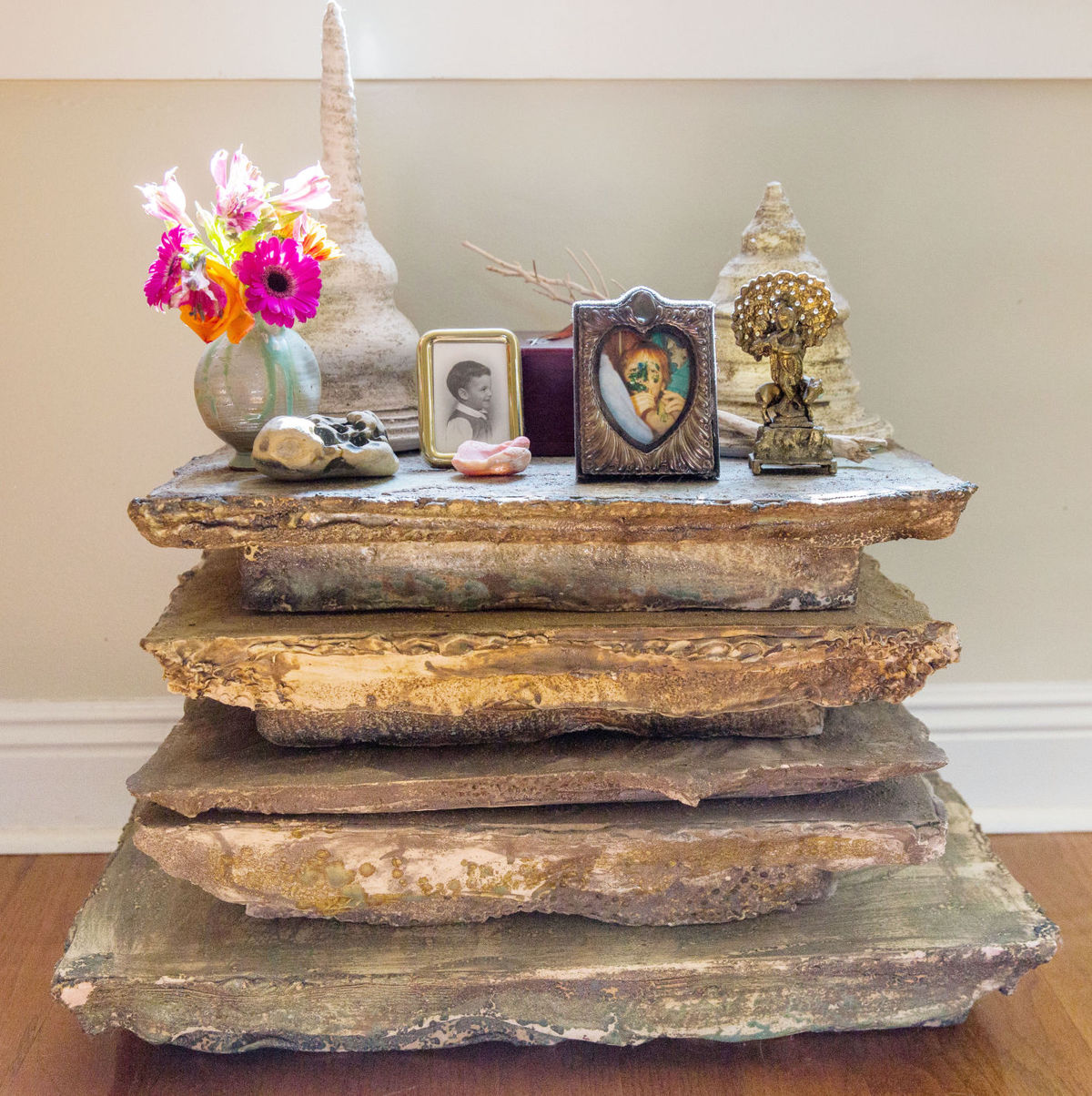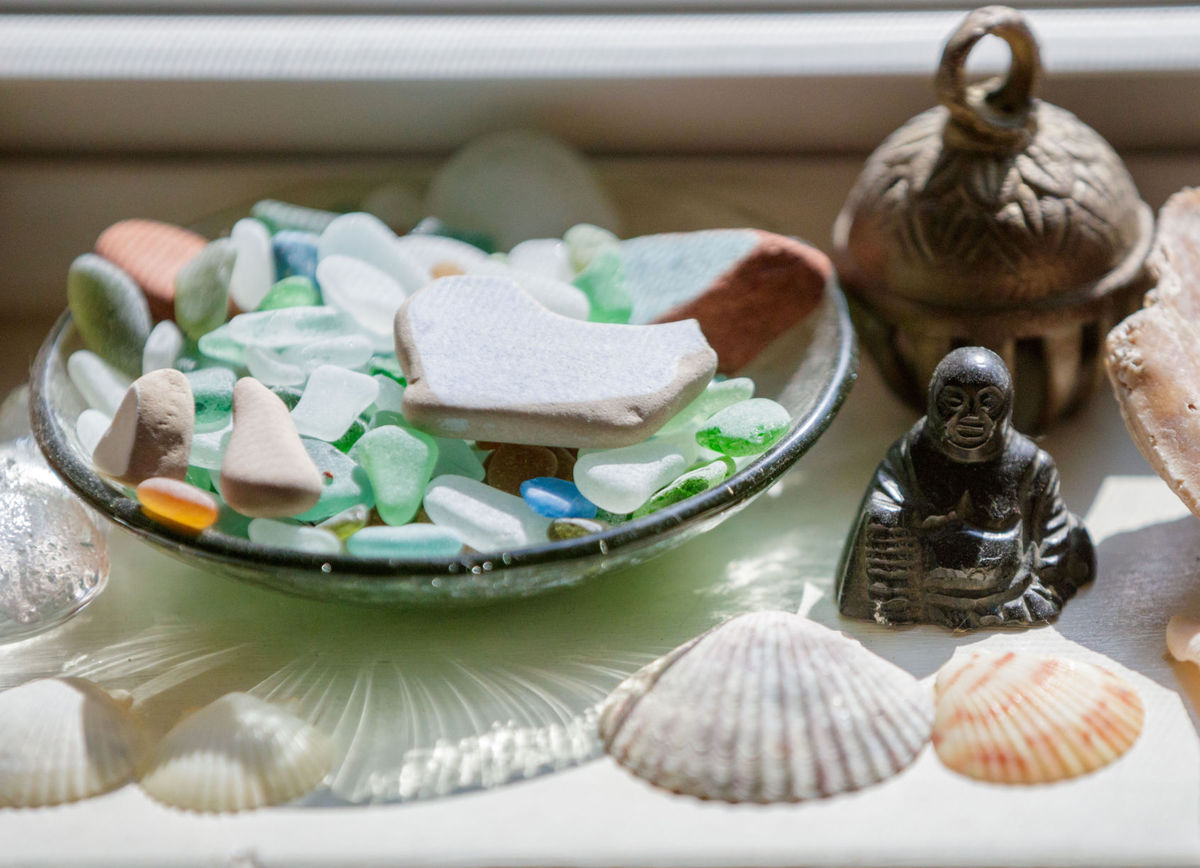- BY CHRIS BYNUM | Special to The Advocate
Sea glass and shells are collected on a small altar in yoga instructor Melanie Fawer’s New Orleans Home.
Advocate staff photo by SOPHIA GERMER.
They are increasingly common, but still one of a kind. Sacred spaces aren’t quite as prevalent as in-house offices and workout rooms, but a designated place for quiet reflection at home is a priority for many people.
What often marks these spaces is a personal altar, one that is as distinctive as the person using it.
Although most people associate altars with churches, temples and shrines, altars in the home are more like the mute button on a smartphone or the pause button on a Roku. The streaming halts, and incoming calls are silenced.
“Many people think it is only for yogis and those with a religious affiliation. Anyone can build a personal altar. Think of it in the same way you hang beautiful art that touches your heart. Or photos of dear ones that remind you of your loving connections. They way you put flowers on your table to remind you of beauty and your connection with the natural world,” says Pransky.
A quiet presence
Local Ashtanga yoga teacher Melanie Fawer has several altars — at home, in her studio and office. For her, the altars are a “quiet presence,” where Fawer spends some time in silence each day. It is as much a practice as it is a place.
“Altars to me represent a sacred space, a constant reminder of prayer, of God, of compassion and gratitude,” she says. Even though Fawer’s altars are very personal to her, the altars in her Uptown studio The Yoga Room are set  up to be community altars, where students and teachers can add their own personal contributions.
up to be community altars, where students and teachers can add their own personal contributions.
The concept of maintaining an altar was instilled in Nancy Torcson when she was a toddler accompanying her mother, a member of a church altar guild, to the Episcopal church to prepare the altar for regular services. Torcson observed the special linens and fresh flowers and candles that went on the table. But it was her mother’s words that stuck with her: “Always keep your own altar.”
She has shared those words with a daughter now studying at Oxford, hoping to pass down the tradition.
Personal altars have become so mainstream that you can find instructions on YouTube, Wikihow and Pinterest. But those who have one say creating a personal altar is totally intuitive.
Drawn to clay
There’s really no building involved when it comes to personal altars. The surface can be a table top, a bedside table, a platform or any flat surface. A window sill can serve the purpose.
Fawer has been drawn to the clay pedestals created by local artist Evelyn Jordan. The organic-looking pedestals,  which Fawer describes as looking as if “they grew out of the earth, as opposed to being formed by clay,” range in size from two inches thick to thicker, and Fawer often stacks them.
which Fawer describes as looking as if “they grew out of the earth, as opposed to being formed by clay,” range in size from two inches thick to thicker, and Fawer often stacks them.
Pransky places little altars on surfaces throughout her house — on bookshelves, around plants, in her vestibule, and sometimes in the middle of her kitchen table. At Thanksgiving, she invites family members to bring items to the table.
Local marketing entrepreneur Megan Hargroder has moved three times in the last three and a half years, re-establishing a home altar each time.
“Each time it’s a little different depending on the space,” says Hargroder, whose current altar faces a window overlooking the backyard.
Fawer says her 8-year-old son Gabriel often contributes to the ever-growing family altar at home, making it a collaborative endeavor with “things we find special when we take walks or trips together — shells from beach trips, bird feathers, a piece from the Redwood Forest, sea glass.”
“It has a picture of my husband’s late father from when he was a child. And a photo of a child I love but who has passed. And the ashes of my beloved cat, Pierre,” says Fawer.
The items one chooses can be “anything that makes you feel heart-centered. Loving. Grateful. Connected. Present,” says Pransky. These items can be a photo of a loved one, a pet, a teacher, or a photo of a favorite place, a piece of nature such as a flower or rock or leaf or a crystal, a poem or piece of art or a mantra written on a piece of paper.
Memory and rituals
“My altars embody the memory and influence of loved ones, the history and rituals of cultures that I hold dear.  They imbue the memory of special places and events,” says Fawer, who has been teaching Ashtanga yoga for more than 20 years, traveling to India often for her yoga education. Many of the items she treasures come from Mysore, the city where her school of yoga was born.
They imbue the memory of special places and events,” says Fawer, who has been teaching Ashtanga yoga for more than 20 years, traveling to India often for her yoga education. Many of the items she treasures come from Mysore, the city where her school of yoga was born.
Hargroder has two morning rituals: her coffee that has been prepared the night before and her 5:45 a.m. visit to her sacred space, where she lights a tea candle to “set the tone” for meditation, or to journal or practice mindful breathing.
But her practice is just as millennial-centric as it is ancient ritual. Yes, there is an app for that. Often Hargroder opens the Insight Timer app on her phone for a guided meditation or sound effects. Earphones, she says, are often necessary for those who live with someone else.
“A clean, uncluttered space begets a clear, uncluttered mind. Meditation is a sacred act that comes from within. In that sense, you are the altar. An altar is a physical manifestation of your inner sacred space,” says Fawer.
*****************
CREATE A PERSONAL ALTAR
Choose a surface
A table top, nightstand, or a window sill will do. Melanie Fawer stacks organic-looking clay pedestals created by local potter Evelyn Jordan.
Add special objects
Gather items that help you feel loving, grateful, connected and “present,” says writer Jillian Pransky. Some ideas: a photo or memento of a loved one, a pet, or a favorite place; a piece of nature such as a feather, seashell or pebble; a poem.
Create a ritual
Light a candle, journal, meditate or practice mindful breathing, suggests entrepreneur Megan Hargroder. Or visit insighttimer.com for a popular, free meditation app.



Comments are closed.